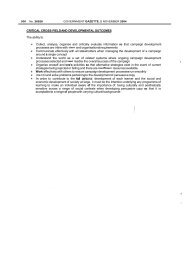The trafficking of children for purposes of sexual exploitation
The trafficking of children for purposes of sexual exploitation
The trafficking of children for purposes of sexual exploitation
You also want an ePaper? Increase the reach of your titles
YUMPU automatically turns print PDFs into web optimized ePapers that Google loves.
3. Terminology<br />
<strong>The</strong> terms, "the child", "child prostitution", "commercial <strong>sexual</strong> <strong>exploitation</strong>", "<strong>sexual</strong> <strong>exploitation</strong>"<br />
and "<strong>trafficking</strong>" are dealt with here. For explanations <strong>of</strong> other terms see the glossary in box 1.<br />
3.1. Who is a child? Defining "the child"<br />
South African legislation, through provisions in specific statutes and the Constitution, defines a<br />
child as a person under the age <strong>of</strong> eighteen years. 15<br />
<strong>The</strong> United Nations Convention on the Rights <strong>of</strong> a Child states that "a child means every human<br />
being below the age <strong>of</strong> 18 years unless under the law applicable to the child the majority is attained<br />
earlier." 16<br />
This report adopts these definitions <strong>of</strong> the child.<br />
A note on the use <strong>of</strong> the terms "girl" and "girls"<br />
<strong>The</strong>se terms are used here to denote the female child and do not reflect <strong>children</strong> and adult women in<br />
the sex industry who refer to themselves as "girls".<br />
Whilst we do not want to negate the females' in the industry's self-referencing, we view women and<br />
<strong>children</strong> as two distinct social categories.<br />
3.2. Defining child prostitution/commercial <strong>sexual</strong> <strong>exploitation</strong> <strong>of</strong> <strong>children</strong>/<strong>sexual</strong> <strong>exploitation</strong><br />
<strong>of</strong> <strong>children</strong><br />
Schurink et al 17 defines prostitution and child prostitution as follows:<br />
"a prostitute is any person who gains his or her livelihood partly or wholly by indiscriminately, without affection,<br />
exchanging <strong>sexual</strong> and/ or non-<strong>sexual</strong> activities (e.g. listening to someone's problems, going out with someone or acting<br />
as someone's regular girl - or boyfriend) <strong>for</strong> money or <strong>for</strong> accommodation, food and/or other valuable articles."<br />
With regard to child prostitution, Schurink et al 18 takes the view that any male or female under the<br />
age <strong>of</strong> 18 years who is coerced or <strong>for</strong>ced (in other words exploited or victimised) to provide sex <strong>for</strong><br />
money or goods is considered to be a child prostitute. (Emphases in the original)<br />
In these terms, by highlighting the voluntary nature <strong>of</strong> adult prostitution and the involuntary nature<br />
<strong>of</strong> child prostitution, Schurink et al essentially captures the most common activities associated with<br />
prostitution. However, whereas this description depicts adults as active agents who benefit<br />
financially and in other ways from prostitution, it clearly does not take the same view with regard to<br />
child prostitution. Within this definition then it is clear that child prostitution can be and should be<br />
regarded as a <strong>for</strong>ced activity associated with coercion, dominance, violence and rape.<br />
<strong>The</strong> United Nations Special Rapporteur on the Sale <strong>of</strong> Children, Child Prostitution and Child<br />
Pornography defined child prostitution thus:<br />
the act <strong>of</strong> engaging or <strong>of</strong>fering the services <strong>of</strong> a child to per<strong>for</strong>m <strong>sexual</strong> acts <strong>for</strong> money or other<br />
consideration with that person or any other person.<br />
Importantly, the Special Rapporteur, Mrs Calcetas-Santos, further noted that<br />
15 <strong>The</strong> Child Care Act (--/1999), as amended. <strong>The</strong> Basic Conditions <strong>of</strong> Employment Act and Section 28(3) <strong>of</strong> the<br />
constitution <strong>of</strong> the Republic <strong>of</strong> South Africa (108/1996) are important.<br />
16 Article 1 <strong>of</strong> the UN Convention on the Rights <strong>of</strong> the Child. 1979<br />
17 W. Schurink, E. Schurink and C. Smit: Children Involved in Prostitution: Exploring a social process to manage the<br />
problem in South Africa, HSRC, 1995, p. 12<br />
18 Ibid p. 12<br />
13
















